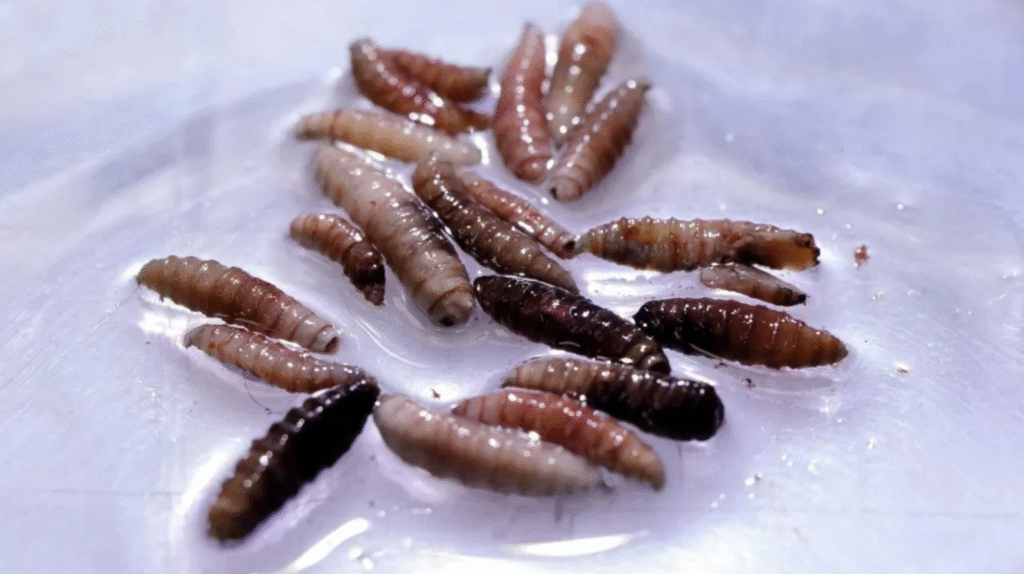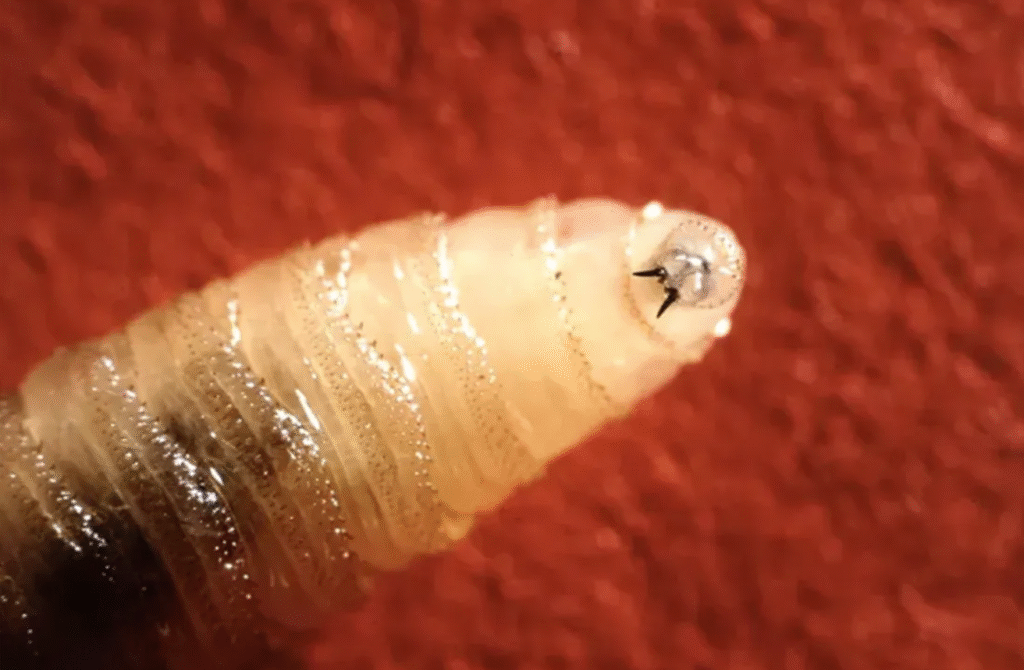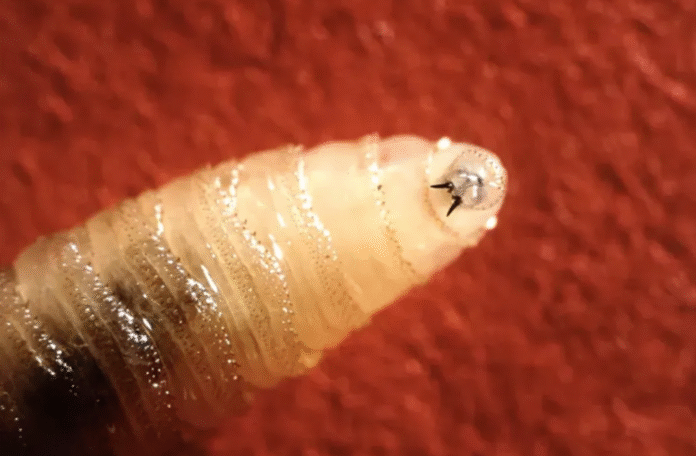US flesh eating parasite has been confirmed in a human for the very first time, marking a deeply alarming development for health officials. On 4 August, the Department of Health and Human Services (HHS) reported that a patient returning from El Salvador was diagnosed with New World screwworm (NWS) myiasis, a rare parasitic infestation caused by flesh-eating fly larvae.
This case has raised widespread concern across medical and agricultural communities, as the parasite has historically devastated livestock and wildlife populations. While the Centers for Disease Control and Prevention (CDC) has emphasized that the risk to the general American public remains very low, the fact that the parasite has now reached US soil underscores how global travel and agricultural trade can spread once-contained diseases.

What Is the US Flesh Eating Parasite?
The US flesh eating parasite in question is the New World screwworm fly (Cochliomyia hominivorax). Its larvae, or maggots, are notorious for burrowing into the flesh of living animals, feeding on healthy tissue. Unlike typical maggots that consume decaying matter, screwworm larvae target live hosts, leading to severe tissue destruction, infection, and in untreated cases, death.
First identified in South America and the Caribbean, the parasite has steadily expanded northward into Central America and Mexico. Human cases are extremely rare but possible, especially in regions with high fly populations. Individuals with open wounds, livestock handlers, and travelers returning from outbreak zones face the greatest risk.
First Human Case Confirmed in the US
Health authorities confirmed the patient developed NWS myiasis after traveling from El Salvador, a country that has been battling outbreaks of the parasite. Andrew Nixon, spokesperson for HHS, said this was the first travel-associated human case of flesh eating parasite myiasis recorded in the US.
The confirmation followed an in-depth investigation by the CDC in collaboration with Maryland’s Department of Health. Medical teams identified the infestation and treated the patient, who is now recovering.
Impact on Humans and Animals
When US flesh eating parasite larvae invade a host, they burrow into wounds and consume healthy tissue. For livestock, this can cause severe suffering, reduced productivity, and even death. For humans, symptoms include:
- Severe wound pain
- Swelling and tissue destruction
- Presence of moving larvae inside the wound
- Secondary bacterial infections
While treatable, delayed diagnosis can lead to devastating outcomes.
According to the US Department of Agriculture (USDA), screwworm infestations in animals could cause catastrophic economic losses, threatening more than $100 billion in the livestock industry. That’s why officials have long treated screwworm as a top-tier agricultural biosecurity threat.
Why the Case Matters for US Public Health
Although the CDC insists that the likelihood of widespread infections is minimal, the confirmation of a US flesh eating parasite case highlights vulnerabilities in public health systems. With increased global travel, pathogens that once seemed confined to remote regions can now reach industrialized nations within hours.
Moreover, climate change is altering the habitats of disease-carrying insects. Warmer temperatures may allow parasites like NWS flies to establish themselves in areas where they were previously unable to survive.
Global Spread of Screwworm Parasite
Efforts to contain the flesh eating screwworm have been ongoing for decades. The USDA, in partnership with international agencies like the Food and Agriculture Organization (FAO), has used techniques such as releasing sterilized male flies to curb reproduction.
Despite these efforts, outbreaks continue to appear in South America, the Caribbean, and Central America. According to the CDC, every country in Central America has now reported cases of the parasite.
The expansion northward is concerning for US authorities. If the screwworm were to establish itself in the southern states, it could devastate cattle, pets, and wildlife populations.

The Role of Livestock and Agriculture
The US flesh eating parasite poses a dual threat, to human health and the economy. Livestock animals, including cattle, sheep, goats, and pigs, are highly susceptible to infestation. Outbreaks could cripple rural communities and destabilize global food supply chains.
Historically, eradication campaigns in the 20th century saved the US cattle industry billions of dollars. But the reappearance of a human case suggests the fight against screwworm is far from over.
What Travelers Need to Know
Travelers to Central America, South America, and the Caribbean should exercise caution. According to the CDC:
- Cover wounds properly when traveling.
- Avoid close contact with livestock in rural regions.
- Seek medical attention immediately if a wound becomes abnormally painful, swollen, or infested.
While US flesh eating parasite infections in humans remain rare, prevention is critical.
Government Response
The USDA’s Animal and Plant Health Inspection Service (APHIS) has stepped up surveillance and is collaborating with the State Department and international partners to prevent outbreaks. Their priority is safeguarding both public health and the agricultural economy.
A USDA statement stressed:
“When NWS fly larvae burrow into the flesh of a living animal, they cause serious, often deadly damage. NWS can infest livestock, pets, wildlife, and, in rare cases, humans.”
This coordinated effort reflects the seriousness with which US agencies view the parasite.
Conclusion: A Wake-Up Call
The confirmed US flesh eating parasite case is not just an isolated medical incident, it’s a stark reminder of how interconnected global health truly is. Diseases once thought confined to distant regions can suddenly appear in highly developed countries, challenging public health systems and threatening industries.
For now, the risk remains low, but the lesson is clear: vigilance, surveillance, and international cooperation are essential to prevent parasites like the New World screwworm from gaining a foothold in the United States.

